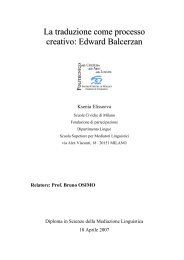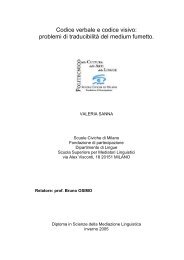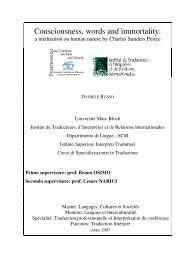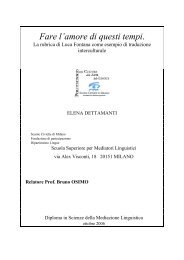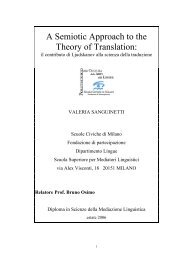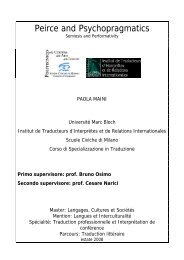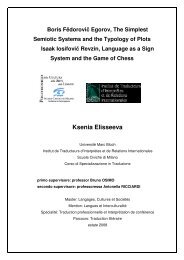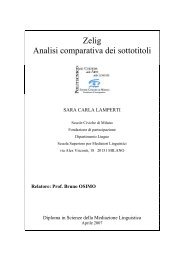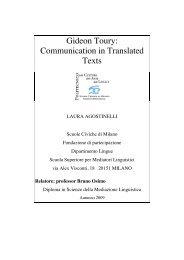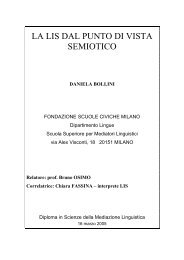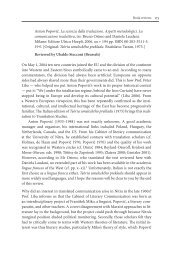Alice in Wonderland - Bruno Osimo, traduzioni, semiotica della ...
Alice in Wonderland - Bruno Osimo, traduzioni, semiotica della ...
Alice in Wonderland - Bruno Osimo, traduzioni, semiotica della ...
You also want an ePaper? Increase the reach of your titles
YUMPU automatically turns print PDFs into web optimized ePapers that Google loves.
Proper Names <strong>in</strong> Translations for Children<br />
<strong>Alice</strong> <strong>in</strong> <strong>Wonderland</strong> as a Case <strong>in</strong> Po<strong>in</strong>t<br />
Author<br />
Christiane Nord<br />
University of Applied Sciences Magdeburg-Stendal, Magdeburg, Germany<br />
1. Prelim<strong>in</strong>ary Considerations<br />
“Proper names are never translated” seems to be a rule deeply rooted <strong>in</strong><br />
many people’s m<strong>in</strong>ds. Yet look<strong>in</strong>g at translated texts we f<strong>in</strong>d that translators<br />
do all sorts of th<strong>in</strong>gs with proper names: non-translation (en[1]. Ada > de.,<br />
es., fr., it. Ada), non-translation that leads to a different pronunciation <strong>in</strong><br />
the target language (en. <strong>Alice</strong> > de., fr. <strong>Alice</strong> [A’li:s], it. <strong>Alice</strong> [a’litche]),<br />
transcription or transliteration from non-Lat<strong>in</strong> alphabets (es. Chaikovski vs.<br />
de. Tschaikowsky or Čaikowskij), morphological adaptation to the target<br />
language (en. <strong>Alice</strong> > es. Alicia), cultural adaptation (en. <strong>Alice</strong> > fi. Liisa),<br />
substitution (en. Ada > br. Mar<strong>in</strong>a, en. Bill > de. Egon) and so on. It is<br />
<strong>in</strong>terest<strong>in</strong>g to note, moreover, that translators do not always use the same<br />
techniques with all the proper names of a particular text they are<br />
translat<strong>in</strong>g.<br />
Translations of fiction and of non-fiction seem to differ only <strong>in</strong> that<br />
there are no substitutions <strong>in</strong> the latter, unless we consider the “translation”<br />
es. Carlos I (of Spa<strong>in</strong>) > de. Karl V. (of Germany) as a cultural substitution.<br />
All the other procedures are found not only <strong>in</strong> fiction, but also <strong>in</strong> non-<br />
fictional texts, where proper names refer to real-life historical persons: es.<br />
el rey Juan Carlos > de. König Juan Carlos, de. Johann Wolfgang von<br />
Goethe > es. Juan Wolfgango de Goethe, en. Pr<strong>in</strong>ce Charles > de. Pr<strong>in</strong>z<br />
Charles, es. el príncipe Carlos, en. Queen Elizabeth II. > de. König<strong>in</strong><br />
25



